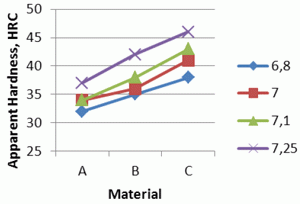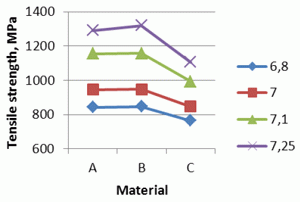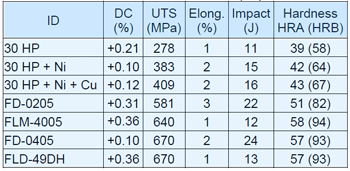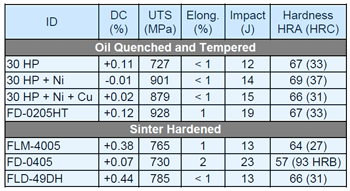Leaner Powder Metallurgy alloy steel powders offer lower cost options
Traditional PM steel compositions have used relatively high levels of Mo, Ni and Cu as alloying elements to provide the desired levels of compressibility to achieve high density, and to obtain the required mechanical properties for high performance PM structural parts. They have also provided flexibility with regard to sintering time and atmosphere, and the sintered parts can be sized.
However, since 2003 there have been continuing fluctuations in the price of all three of the above mentioned alloying elements rising to considerable peaks in 2008 and beyond. In addition there are environmental concerns relating to the use elemental nickel powder in PM part production, and problems of recycling for Cu containing steels.
These developments have pushed iron powder producers to develop leaner, and hence lower cost alloy powders by dramatically reducing the amount of alloying additions traditionally used, or by the use of non-traditional alloying elements. The ‘Sintered Steels’ sessions at Euro PM2011 in Barcelona included three presentations on newly developed ‘lean alloy’ steel powders from Pometon SpA, Höganäs AB, and Hoeganaes Corp.
Lean Cr-containing steel powders
Pometon SpA of Maerne, Italy, reported on the development of two new lean Cr-containing alloy powders designated ECOSINT A (Fe-1.4Cr-0.8Mo-0.4Ni-0.3graphite) and ECOSINT C (Fe-1.4Cr-0.8Mo-1.0Ni-0-1.9Cu-0.3graphite). Sandra Bueno and colleagues from Pometon and CEIT (San Sebastian, Spain) stated that both grades of powders were pressed to a density of around 7.05 g/cm3 and sintered at 1120°C followed by a carburising treatment, whilst the ECOSINT C powder grade was also sintered at 1240°C followed by accelerated cooling and a tempering treatment.

Table1 Mechanical properties for Alloy 2 (EcosintA) with a density of 7.05 g/cm3in the as-heat treated condition and Alloy 3 (Ecosint C) tempered after sinter-hardening. (From paper by S. Bueno, etal, ‘Lean-Cr Containing Powders for High Performance PM Steel Grades’ presented at the EuroPM2011 Conference, Barcelona, October 10-13, 2011. Published in the Conference Proceedings by EPMA, Shrewsbury, UK)
It was emphasised that ECOSINT A exhibited a very attractive response to carburising treatment despite being a steel grade with less than half the total amount of Ni and Cu alloying elements as compared to traditional PM steels. Hardness for this grade was given as 41 HRC at the sintered density of 7.05 g/cm3. The ECOSINT C powder was said to offer the possibility of obtaining martensitic microstructures after sinter-hardening, giving high hardness (34 HRC) when sintered at 1120°C and 1240°C , with good mechanical strength and significant economical advantages over other PM steels as the secondary carburising treatment is avoided.
Cost effective lean diffusion alloyed powders for gears

Fig. 1 Apparent hardness for lean Distaloy AQ powder
(Material A = 0.5% graphite; B = 0.6% graphite;
C = 0.8% graphite). (From paper by U. Engström, etal,
’Cost Effective Material for Heat Treated Gear Applications’
presented at the EuroPM2011 Conference, Barcelona,
October 10-13, 2011. Published in the Conference
Proceedings by EPMA, Shrewsbury, UK)
Ulf Engström, Manager – Technical Sales at Höganäs AB, Sweden, reported on a new ‘lean’ diffusion alloyed powder intended for the production of heat treated PM parts, including gears. Designated Distaloy AQ the new powder’s composition contains only 0.5Ni and 0.5Mo where the Ni and Mo have been diffusion bonded to the base water atomised iron powder giving maximum compressibility. Engström stated that the low alloying content results in good machinability and sizing properties in the as-sintered condition, and provides adequate hardenability to achieve high hardness and strength after heat treatment (Fig.1).

Fig.2 Tensile strength for Distaloy AQ powders
C = 0.8% graphite). (From paper by U. Engström, etal,
’Cost Effective Material for Heat Treated Gear Applications’
presented at the EuroPM2011 Conference, Barcelona,
October 10-13, 2011. Published in the Conference
Proceedings by EPMA, Shrewsbury, UK)
Distaloy AQ powder containing different amounts of graphite (0.5 to 0.8%) was consolidated to a density level ranging from 6.8 to 7.25 g/cm3, and the compacts were sintered in a mesh belt furnace at 1120C for 30 min in 90/10 N2/H2 atmosphere with a cooling rate of 0.5 C/s. The sintered parts were heat treated by austenitising the specimens at 920°C for 20 minutes at different C-potentials to create both through hardening and case hardening. Oil quench was applied at a temperature of 60°C, and the specimens were tempered at 200°C for 1 hour in air. Engström stated that the ultimate tensile strength (UTS) obtained after quench and tempering of the three Distaloy AQ powders (A, B and C in the Fig.2) increased with increasing density. He said that a UTS ranging from 800 MPa to 1300 MPa could be achieved at carbon content between 0.5% and 0.6%. For material C with the highest carbon content level of 0.70%, the UTS was found to drop off due to an increased brittleness of the material at this carbon level.
Plane bending fatigue performance of Distaloy AQ was reported to be slightly higher compared to the more highly alloyed Distaloy AB material. Plane bending fatigue limits of 381 MPa (σ50%) and 358 MPa (σ90%) were achieved at a density of 7.16 g/cm3. For one grade of Distaloy AQ material a gear tooth root bending fatigue limit higher than 550 MPa (σ 90) was obtained for sintered gears.
Leaner alloys for the PM industry
Peter Sokolowski of Hoeganaes Corp., Cinnaminson, New Jersey, introduced a newly developed Mn-containing alloy system designated ANCORBOND FLM which he stated combined the benefits of Mn and moderate amounts of Mo to produce cost-effective alternatives to high-alloy hybrid and diffusion-alloyed PM steels. He stated that this alloy system is free from Cu and Ni and has been designed for sintering at the normal temperature of 1120°C. It is suitable for as-sintered, sinter-hardened, and induction-hardened applications, he said.

Table 2 Compositions of PM steels used to evaluate properties of lean alloys. (From paper by P. Sokolowski and B. Lindsley ‘Leaner Alloys for the PM Industry’ presented at the EuroPM2011 Conference, Barcelona, October 10-13, 2011. Published in the Conference Proceedings by EPMA, Shrewsbury, UK)
Sokolowski presented results from compacting various commercially available ‘lean’ PM steel alloy grades, and also the lean ANCORBOND FLM powders containing 0.75 wt% EBS wax , 0.6% graphite, 0.5 Mo and 1.3 Mn (Table 2). Compacts were pressed to 7.0 g/cm3 density, followed by sintering in a continuous-belt furnace at 1120°C for 15 minutes in a 90% N2 and 10% H2 atmosphere. He stated that as-sintered properties were evaluated using a cooling rate of 0.7 °C/s from 650°C to 315°C. Sinter-hardened properties were achieved using an accelerated cooling system producing a cooling rate of 1.6 C/s.

Table 3 As-sintered mechanical properties of PM steels and
lean alloys. (From paper by P. Sokolowski and B. Lindsley
‘Leaner Alloys for the PM Industry’ presented at the
EuroPM2011 Conference, Barcelona, October 10-13, 2011.
Published in the Conference Proceedings by EPMA)
It was reported that whilst the heavily alloyed diffusion alloys are superior to the leaner alloys in the as-sintered condition (Table 3), heat treating or sinter hardening the lean alloys greatly enhances their performance (Table 4). Sokolowski stated that whilst the Mn-steel, ANCORBOND FLM-4005, has competitive tensile strength with the diffusion alloys, it has much lower impact properties as a result of not having Ni at particle boundaries. However, sinter hardening was effective in these alloys with substantial improvements in strength and hardness.

Table 4 Mechanical properties of heat treated and sinter
hardened PM steels and lean steels. (From paper by P.
Sokolowski and B. Lindsley ‘Leaner Alloys for the PM Industry’
presented at the EuroPM2011 Conference, Barcelona, October
10-13, 2011. Published in the Conference Proceedings by
EPMA, Shrewsbury)
It is, therefore, proposed that the total alloy content found in popular oil quenched PM steel alloys could be reduced to meet PM part specifications and manufacturing demands and still provide acceptable fatigue performance. Sokolowski concluded by stating that several lean alloy options are now available to parts makers capable of reducing costs in PM steel alloys. The selection of ‘lean’ alloys, however, depends on processing capabilities.
News | Articles | Market reviews | Search directory | Subscribe to e-newsletter





